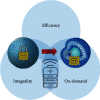Lipid-Based Intelligent Vehicle Capabilitized with Physical and Physiological Activation
- PMID: 36452433
- PMCID: PMC9680525
- DOI: 10.34133/2022/9808429
Lipid-Based Intelligent Vehicle Capabilitized with Physical and Physiological Activation
Abstract
Intelligent drug delivery system based on "stimulus-response" mode emerging a promising perspective in next generation lipid-based nanoparticle. Here, we classify signal sources into physical and physiological stimulation according to their origin. The physical signals include temperature, ultrasound, and electromagnetic wave, while physiological signals involve pH, redox condition, and associated proteins. We first summarize external physical response from three main points about efficiency, particle state, and on-demand release. Afterwards, we describe how to design drug delivery using the physiological environment in vivo and present different current application methods. Lastly, we draw a vision of possible future development.
Copyright © 2022 Fuxue Zhang et al.
Conflict of interest statement
The authors declare that they have no conflict of interest.
Figures










Similar articles
-
Dual and multi-stimuli responsive polymeric nanoparticles for programmed site-specific drug delivery.Biomaterials. 2013 May;34(14):3647-57. doi: 10.1016/j.biomaterials.2013.01.084. Epub 2013 Feb 14. Biomaterials. 2013. PMID: 23415642 Review.
-
Advances in Intelligent Stimuli-Responsive Microneedle for Biomedical Applications.Macromol Biosci. 2023 Sep;23(9):e2300014. doi: 10.1002/mabi.202300014. Epub 2023 May 5. Macromol Biosci. 2023. PMID: 37055877 Review.
-
Planning Implications Related to Sterilization-Sensitive Science Investigations Associated with Mars Sample Return (MSR).Astrobiology. 2022 Jun;22(S1):S112-S164. doi: 10.1089/AST.2021.0113. Epub 2022 May 19. Astrobiology. 2022. PMID: 34904892
-
Stimuli-responsive Polymeric Nanosystems for Therapeutic Applications.Curr Pharm Des. 2022;28(11):910-921. doi: 10.2174/1381612827666211208150210. Curr Pharm Des. 2022. PMID: 34879797 Review.
-
Investigation of Eutectic Mixtures of Fatty Acids as a Novel Construct for Temperature-Responsive Drug Delivery.Int J Nanomedicine. 2022 May 26;17:2413-2434. doi: 10.2147/IJN.S359664. eCollection 2022. Int J Nanomedicine. 2022. Retraction in: Int J Nanomedicine. 2023 Nov 07;18:6409-6410. doi: 10.2147/IJN.S448407. PMID: 35656165 Free PMC article. Retracted.
Cited by
-
Progesterone receptor potentiates macropinocytosis through CDC42 in pancreatic ductal adenocarcinoma.Oncogenesis. 2024 Feb 29;13(1):10. doi: 10.1038/s41389-024-00512-7. Oncogenesis. 2024. PMID: 38424455 Free PMC article.
-
Thermal and Magnetic Dual-Responsive Catheter-Assisted Shape Memory Microrobots for Multistage Vascular Embolization.Research (Wash D C). 2024 Mar 26;7:0339. doi: 10.34133/research.0339. eCollection 2024. Research (Wash D C). 2024. PMID: 38550780 Free PMC article.
-
Oral delivery of therapeutic proteins by engineered bacterial type zero secretion system.Nat Commun. 2025 Feb 21;16(1):1862. doi: 10.1038/s41467-025-57153-6. Nat Commun. 2025. PMID: 39984501 Free PMC article.
-
Reliable high-PAP-1-loaded polymeric micelles for cancer therapy: preparation, characterization, and evaluation of anti-tumor efficacy.Drug Deliv. 2025 Dec;32(1):2490269. doi: 10.1080/10717544.2025.2490269. Epub 2025 Apr 10. Drug Deliv. 2025. PMID: 40207975 Free PMC article.
-
Capturing the dynamic integrity of carbocyanine fluorophore-based lipid nanoparticles using the FRET technique.J Mater Chem B. 2025 Feb 12;13(7):2295-2305. doi: 10.1039/d4tb02653e. J Mater Chem B. 2025. PMID: 39886899 Free PMC article.
References
Publication types
LinkOut - more resources
Full Text Sources
Other Literature Sources

